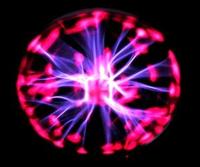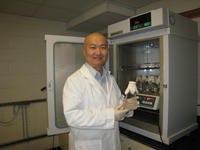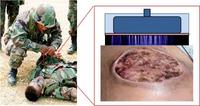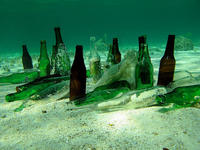-
Collecting rainwater could save U.S. residents $90 million a year

Simply collecting rainwater could save U.S. residents millions of dollars each year on their water bills and drastically cut down on water consumption; a new study by the Natural Resources Defense Council examined the potential cost-savings in eight U.S. cities and found that residents could collectively save $90 million or more annually
-
-
Study: No direct link between fracking, groundwater contamination
Hydraulic fracturing (fracking) involves the high-pressure injection of water, sand and chemicals into a shale seam, which causes the rock to shatter, releasing natural gas; preliminary findings from a study on the use of hydraulic fracturing in shale gas development suggest no direct link to reports of groundwater contamination
-
-
Groundwaterin some parts of U.S. susceptible to radium contamination
A recent U.S. Geological Survey (USGS) study found that groundwater in aquifers on the East Coast and in the Central United States has the highest risk of contamination from radium, a naturally occurring radioactive element and known carcinogen
-
-
Advances in the use of photocatalysts to help keep water clean safe
Photocatalysis involves the acceleration of chemical reactions using the power of light; researchers experiment with different types of photocatalysts to reduce nitrates in water
-
-
Innovative method of water purification
The UN estimates that about 1.1 billion people currently lack access to safe water; forecasts suggest that freshwater may become the “oil” of the twenty-first century — expensive, scarce, and the cause of geo-political conflicts; scientists show a new method for purifying water
-
-
Using bacteria to detect toxins in water
Biologists and bioengineers at UC San Diego have created a living neon sign composed of millions of bacterial cells that periodically fluoresce in unison like blinking light bulbs; because bacteria are sensitive to many kinds of environmental pollutants and organisms, the scientists believe this approach could be used to design low cost bacterial biosensors capable of detecting an array of heavy metal pollutants and disease-causing organisms
-
-
Sustaining high-quality groundwater
Intensive agriculture practices developed during the past century have helped improve food security for many people but have also added to nitrate pollution in surface and ground waters
-
-
Innovative device removes heavy metals from water

Engineers at Brown University have developed a system that cleanly and efficiently removes trace heavy metals from water; in experiments, the researchers showed the system reduced cadmium, copper, and nickel concentrations, returning contaminated water to near or below federally acceptable standards; the technique is scalable and has viable commercial applications, especially in the environmental remediation and metal recovery fields
-
-
Portable wastewater system generates energy, produces drinking water

Researchers are working to develop a portable wastewater treatment system that could improve the military’s efficiency; the solar-bio-nano project also will generate energy and produce drinking water, thus providing a potential blueprint for the future of municipal/agricultural wastewater treatment systems
-
-
Ionized plasmas as cheap sterilizer in tough places

Scientists show that ionized plasmas like those in neon lights and plasma TVs not only can sterilize water, but make it antimicrobial; these plasma devices could be life-savers in developing countries, disaster areas, or on the battlefield where sterile water for medical use is in short supply and expensive to produce
-
-
Innovative ultrasonic nozzle changes the way water cleans
Scientists have developed a revolutionary ultrasonic attachment for taps, which massively enhances the ability of water to clean; currently, industry uses excessive water, power, and additives for cleaning
-
-
Also noted
Water Distribution Systems: A Potential Terrorist Tactic | Austrian student fights Facebook over privacy | Cyber attacks hit Japan diplomatic missions | DoD, VA increase rabies-prevention efforts | Economic troubles take toll on U.S. police departments | Ten years on, Patriot Act remains controversial
-
-
Waste glass cleans up water

A simple method converts waste glass into a material which can be used to remove pollutants from contaminated water; the method uses colored glass which is being stockpiled in the United Kingdom as there is less recycling demand for green and brown bottles than there is for clear bottles
-
-
Reducing exposure to groundwater arsenic
Well diggers in Bangladesh will soon be able to take advantage of a cell phone-based data system, developed at the Earth Institute, to target safe groundwater aquifers for installing new wells that are not tainted with arsenic
-
-
Virus movement in Wisconsin groundwater
Drinking water taken from a deep aquifer protected by a semi-permeable layer of rock should be safe because the water is protected from many contaminants, including viruses — but is it safe? University of Wisconsin scientists find virus particles in many deep Madison, Wisconsin water wells, raising questions about how viruses, which should not survive more than two years underground, reached so deep and survive for so long
-
- All
- Regional
- Water
- Biometrics
- Borders/Immig
- Business
- Cybersecurity
- Detection
- Disasters
- Government
- Infrastructure
- International
- Public health
- Public Safety
- Communication interoperabillity
- Emergency services
- Emergency medical services
- Fire
- First response
- IEDs
- Law Enforcement
- Law Enforcement Technology
- Military technology
- Nonlethal weapons
- Nuclear weapons
- Personal protection equipment
- Police
- Notification /alert systems
- Situational awareness
- Weapons systems
- Sci-Tech
- Sector Reports
- Surveillance
- Transportation
Advertising & Marketing: advertise@newswirepubs.com
Editorial: editor@newswirepubs.com
General: info@newswirepubs.com
2010-2011 © News Wire Publications, LLC News Wire Publications, LLC
220 Old Country Road | Suite 200 | Mineola | New York | 11501
Permissions and Policies
Editorial: editor@newswirepubs.com
General: info@newswirepubs.com
2010-2011 © News Wire Publications, LLC News Wire Publications, LLC
220 Old Country Road | Suite 200 | Mineola | New York | 11501
Permissions and Policies
